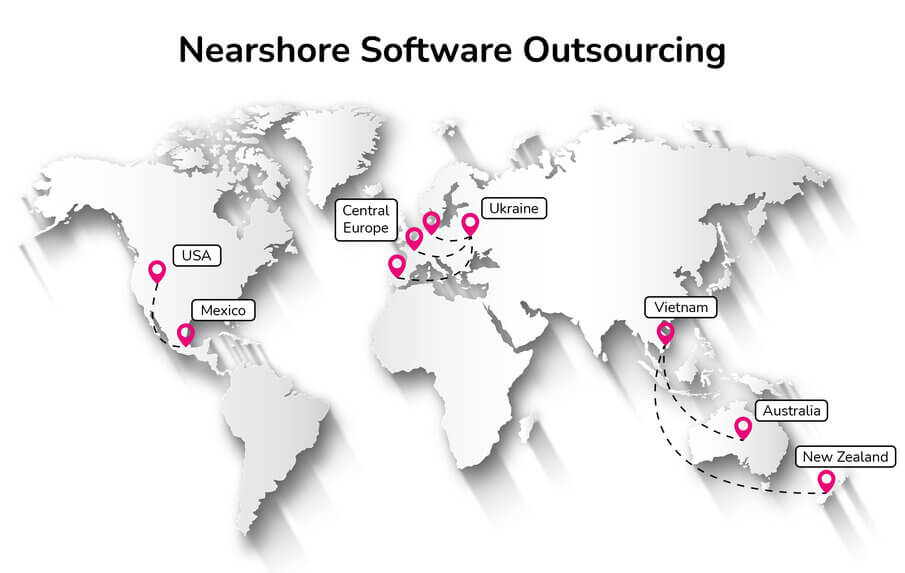A Comprehensive Guide to Nearshore Software Development
Does the constant pressure to innovate in today’s software-driven world leave you feeling like you’re falling behind? Building an in-house development team can be a drain on your resources, both financially and in terms of time. Look beyond borders, but not by a hemisphere. Nearshore software development offers a compelling alternative, strategically leveraging the power of geographically close development teams. This guide dives deep into the advantages of nearshore development, equipping you to make informed decisions and build high-quality software efficiently. By embracing nearshore development, you can unlock a strategic advantage and propel your business forward in the ever-evolving world of technology.
What is Nearshore Software Development?

Nearshore software development is a strategic outsourcing model where you partner with a software development team located in a nearby country. This proximity offers a significant advantage – a comfortable time zone overlap, typically within a 1- to 4-hour difference. This allows for smoother communication, real-time collaboration, and efficient project management compared to geographically distant teams. Imagine being able to hold clear discussions, address questions promptly, and maintain a strong working relationship without the challenges of significant time zone gaps.
In essence, nearshore development bridges the gap between the familiarity and ease of working with an onshore team (in your own country) and the cost benefits often associated with offshore outsourcing (teams located further away). You gain access to a talented pool of developers while maintaining clear communication channels and a more streamlined development process.
Why Consider Nearshore Software Development?
The ever-growing demand for skilled software developers can leave in-house teams feeling stretched thin and budgets feeling squeezed. While building your own team offers a sense of control, the recruitment process can be time-consuming and expensive, especially in a competitive talent market. This is where nearshore software development emerges as a compelling solution, offering a strategic advantage on several fronts:
1. Cost Savings:
Nearshore locations often have lower development costs compared to onshore teams. This can be attributed to factors like salary variations and operational expenses. You can potentially save tens of thousands of dollars on a project by leveraging nearshore talent, freeing up resources to invest in other areas of your business.
2. Access to a Diverse Talent Pool:
Don’t be limited by your local talent market. Nearshore locations are often hubs for skilled software engineers with a strong educational background and experience with various technologies. This wider pool allows you to find developers who possess the specific skillsets your project requires, whether it’s expertise in cutting-edge frameworks or deep knowledge of legacy systems.
3. Seamless Communication and Collaboration:
Forget the challenges of working across vast time zones. Nearshore development teams operate within a comfortable time zone overlap, typically within a 1- to 4-hour difference. This facilitates real-time communication, allowing you to hold clear discussions, address questions promptly, and provide ongoing feedback throughout the development process. This fosters a strong working relationship with your development partner, leading to fewer misunderstandings and a smoother overall project experience.
4. Enhanced Project Management:
The geographical proximity of nearshore teams offers a distinct advantage when it comes to project management. You can easily schedule meetings, conduct code reviews, and collaborate on tasks in real-time. This level of collaboration allows for a more agile and iterative development process, where adjustments can be made quickly based on your feedback. Additionally, the closer proximity can facilitate easier oversight if needed, allowing you to stay informed about the project’s progress and address any potential roadblocks efficiently.
In essence, nearshore development offers a win-win scenario. You gain access to a wider range of talent at a potentially lower cost, while still enjoying the benefits of clear communication and streamlined project management. This combination can give your business a strategic edge, allowing you to develop high-quality software efficiently and stay ahead of the curve in today’s competitive landscape.
Advantages of Nearshore Software Development

Beyond the initial appeal of cost savings and wider talent pool, nearshore software development offers a multitude of advantages that can significantly benefit your business. Let’s delve deeper into these key benefits:
1. Cost-Effectiveness:
- Reduced Development Expenses: As mentioned earlier, nearshore development teams typically have lower salaries compared to their onshore counterparts. This translates to important cost savings on your project. You can potentially free up tens of thousands of dollars to reinvest in other areas of your business or allocate resources towards future development endeavors.
- Potential Tax Benefits: Depending on the nearshore location you choose, you might be eligible for tax breaks or incentives offered by the government to attract foreign investment. These tax benefits can further reduce your overall development costs.
2. Access to Skilled Talent:
- Diverse Skillsets and Experience: Nearshore locations often boast a large pool of qualified software engineers with a strong educational background and experience working on various projects. This diversity allows you to find the perfect fit for your needs, whether you require expertise in cutting-edge frameworks like machine learning or deep knowledge of legacy systems to maintain existing applications.
- Faster Talent Acquisition: The competitive talent market can make it challenging to find the right developers in-house. Nearshore development allows you to tap into a readily available pool of skilled professionals, potentially accelerating the recruitment process and getting your project started sooner.
3. Streamlined Communication and Collaboration:
- Overlapping Time Zones: One of the biggest advantages of nearshore development is the convenience of overlapping time zones. This typically falls within a 1- to 4-hour difference, eliminating the communication challenges associated with significant time zone gaps. You can easily schedule meetings, conduct real-time discussions, and address questions promptly, fostering a more collaborative and productive working relationship with your development team.
- Similar Cultural Understanding: Nearshore locations often share some cultural similarities with your own country. This can lead to a better understanding of communication styles, work ethic, and business practices, minimizing misunderstandings and fostering a smoother overall collaboration.
4. Improved Project Management:
- Proven Methodologies: Established nearshore development partners often have well-defined and proven methodologies for project management. These methodologies can be tailored to your specific needs, whether you prefer a traditional Waterfall approach or a more agile development process.
- Closer Geographical Proximity: The physical proximity of nearshore teams allows for easier oversight (if necessary) and a more collaborative development process. You can conduct code reviews, collaborate on tasks in real-time, and stay informed about the project’s progress more readily. This can lead to faster issue resolution and ensure the project stays on track to meet your deadlines and goals.
By leveraging these advantages, nearshore software development can become a strategic cornerstone for your business. It allows you to access a wider range of talent at a potentially lower cost, while still enjoying the benefits of clear communication, streamlined project management, and a collaborative development process. This combination can empower your business to develop innovative and high-quality software efficiently, giving you a competitive edge in the ever-evolving world of technology.
Things to Consider When Choosing a Nearshore Partner

Finding the right nearshore partner is crucial for a successful software development experience. While the advantages are compelling, careful consideration should be given to ensure a good fit for your specific needs. Here are some key factors to evaluate when choosing a nearshore partner:
1. Technical Expertise:
- Matching Skillset: A critical first step is thoroughly evaluating the nearshore partner’s technical expertise. Ensure their skillset aligns perfectly with the project requirements. Do they have experience working with the specific technologies, frameworks, and programming languages your project demands?
- Project Portfolio and References: Requesting a portfolio of the partner’s past projects can be highly insightful. Look for projects similar to yours in terms of scope and complexity. Additionally, reaching out to references from their previous clients can provide valuable firsthand perspectives on their development capabilities and overall work ethic.
2. Communication and Cultural Fit:
- Clear Communication Channels: Having clear and established communication channels is paramount for a successful nearshore partnership. Evaluate the partner’s communication style and preferred methods (e.g., video conferencing, project management tools). Ensure they prioritize timely responses and are comfortable with your preferred level of communication.
- Cultural Alignment: Cultural understanding can significantly impact collaboration and project success. While nearshore locations generally offer some cultural similarities, it’s important to assess potential differences in communication styles, work ethic, and business practices. Look for a partner that demonstrates a willingness to adapt and collaborate effectively within your preferred work culture.
3. Project Management Style:
- Development Methodology: Do you have a preference for a traditional Waterfall approach or a more agile development methodology like Scrum? Ensure the nearshore partner has experience and expertise working with your preferred development methodology. This alignment will streamline the workflow and ensure everyone is on the same page throughout the project lifecycle.
- Remote Team Management: Evaluate the partner’s experience in managing remote development teams. Look for established processes for task allocation, progress tracking, and performance evaluation. Understanding their approach to remote team management will give you confidence in their ability to deliver your project effectively.
4. Legal and Security Considerations:
- Contractual Agreements: A well-defined contract is vital for any outsourcing arrangement. The contract should clearly outline ownership of intellectual property, confidentiality clauses, dispute resolution procedures, and service level agreements (SLAs) to ensure project deliverables meet your expectations.
- Data Security Protocols: Data security is paramount, especially when dealing with sensitive information. Evaluate the nearshore partner’s data security protocols and compliance with relevant industry regulations and data protection laws. Ensure they have robust security measures in place to safeguard your data throughout the development process.
By carefully considering these factors, you can make an informed decision when choosing a nearshore partner. The right partner will possess the technical expertise, communication style, and project management approach that aligns perfectly with your needs. This will set the stage for a successful and collaborative development experience, allowing you to leverage the full potential of nearshore software development.
Best Practices for Successful Nearshore Software Development

Having identified the ideal nearshore partner, the groundwork is laid for a successful software development project. However, implementing certain best practices can further optimize the collaboration and ensure a smooth development process. Here are some key practices to consider:
1. Defining Clear Project Requirements and Goals:
- Detailed Specifications: The foundation for any successful software development project is a clear understanding of the desired outcome. Invest time in creating detailed specifications that outline the project scope, functionalities, and user stories. These specifications should be clearly documented and shared with your nearshore partner to ensure everyone is aligned on the project vision.
- Measurable Success Metrics: Establishing measurable success metrics early on allows you to track progress and evaluate the project’s effectiveness. These metrics could include key performance indicators (KPIs) related to functionality, user adoption, or performance benchmarks. Regularly monitoring these metrics allows for adjustments to be made as needed, ensuring the project remains on track to meet its goals.
2. Establishing Effective Communication Channels:
- Regular Meetings and Video Conferencing: Maintaining open and consistent communication is crucial for a successful nearshore partnership. Schedule regular meetings, preferably via video conferencing, to discuss project progress, address any roadblocks, and provide ongoing feedback. This allows for real-time interaction and fosters a more collaborative working environment.
- Dedicated Points of Contact: Designate dedicated points of contact on both sides of the partnership. These individuals will act as central communication hubs, ensuring all questions, updates, and information flow through a streamlined channel. This reduces the risk of confusion and ensures timely responses to any inquiries.
3. Building Strong Relationships with Your Partner Team:
- Open Communication and Transparency: Building trust and a strong working relationship with your nearshore development team is essential. Practice open communication and transparency throughout the project lifecycle. This includes keeping the team informed about project changes, challenges, and overall business goals.
- Team-Building Activities: While physical proximity can be an advantage, fostering a sense of camaraderie with your nearshore team goes beyond geographical location. Consider incorporating virtual team-building activities to promote collaboration, improve communication, and build stronger relationships within the team.
By implementing these best practices, you can create a collaborative and productive working environment with your nearshore partner. This will not only ensure smooth project execution but also foster a long-term and successful partnership that allows you to leverage the full potential of nearshore software development.
Conclusion
Imagine building cutting-edge software with the combined power of a global talent pool and seamless communication. Nearshore development makes it a reality. At ONextDigital, we’re experts in harnessing this advantage to deliver exceptional web applications, mobile apps, and white-label software solutions for your business. Let us show you how nearshore development can be your secret weapon for success. Our team of specialists will work closely with you to understand your vision, leverage the power of nearshore development, and deliver a software solution that exceeds your expectations. Don’t wait – unlock the efficiency and expertise of nearshore development with ONextDigital. Contact us today.




